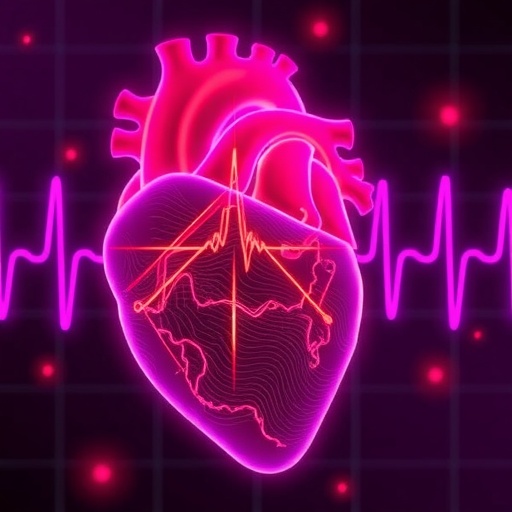Atrial fibrillation (AF) represents a significant clinical challenge in the management of patients with continuous-flow left ventricular assist devices (CF-LVADs). This condition affects the heart’s rhythm and often complicates the clinical trajectory of patients who are already battling advanced heart failure. The advent of CF-LVADs has marked a transformative period in mechanical circulatory support, offering a lifeline to those with severe cardiac dysfunction; however, the introduction of such devices has concurrently raised concerns regarding the incidence and consequences of concomitant atrial fibrillation.
In CF-LVAD patients, the presence of atrial fibrillation can alter hemodynamics, potentially leading to diminished cardiac output. This rhythm disturbance may arise from several contributing factors, including the underlying pathology of heart failure, structural heart changes due to prolonged LVAD support, or electrical disturbances exacerbated by device-related conditions. The interplay of these various factors creates a complex clinical environment, making the understanding of atrial fibrillation’s impact essential for optimizing patient care and outcomes.
Pathophysiologically, atrial fibrillation disrupts the normal electrical activity of the heart, leading to a rapid and irregular heart rate that can further strain an already compromised cardiovascular system. In patients with CF-LVADs, this irregular rhythm can herald a decline in the overall effectiveness of the device. It is vital to monitor these patients closely, given that the alteration in rhythm can contribute to increased diastolic and systolic dysfunction, and introduce complications such as thromboembolism.
Moreover, the occurrence of atrial fibrillation in the context of CF-LVADs can escalate the risk of adverse outcomes, including stroke, heart failure exacerbations, and hospitalizations. Understanding the specific mechanisms that link AF with worsening pathology in LVAD patients could guide interventions aimed at mitigating these risks. For instance, anticoagulation strategies, electrical cardioversion, and rhythm control may need to be tailored uniquely to this population to safeguard against deteriorating health conditions.
Advancements in imaging and cardiac monitoring techniques provide new avenues to study the impact of atrial fibrillation on patient outcomes. Cardiologists can utilize echocardiography, electrocardiography, and advanced cardiac imaging modalities to assess the structural and functional implications of AF in CF-LVAD patients. These tools enable healthcare providers to make more informed decisions regarding treatment pathways, modal interventions, and the timing of potential device adjustments.
There is a growing body of evidence highlighting the need for multidisciplinary approaches to manage AF in patients with CF-LVADs effectively. Collaborations among cardiologists, electrophysiologists, and heart failure specialists can foster comprehensive care strategies that address the unique physiological challenges posed by atrial fibrillation. This team-based approach is crucial in determining individualized therapy regimes that balance the risks associated with anticoagulation against the need to maintain optimal device function and patient safety.
Despite the potential for effective management strategies, several gaps in knowledge remain regarding the full impact of atrial fibrillation on CF-LVAD outcomes. For instance, further longitudinal studies are necessary to evaluate the long-term consequences of AF in this cohort, particularly regarding mortality rates and functional status. A deeper understanding of the epidemiology of atrial fibrillation in CF-LVAD patients could lead to risk stratification tools and algorithms that enhance clinical decision-making.
Furthermore, the psychosocial aspects of living with both atrial fibrillation and LVAD support cannot be understated. Patients often face significant psychological burdens related to their heart conditions, including anxiety and depression, which can negatively influence adherence to treatment plans. Addressing the psychological well-being of these patients through integrated support services and counseling could result in more favorable health outcomes.
Emerging therapies also hold promise in the realm of atrial fibrillation management among CF-LVAD patients. Investigational agents aimed at restoring normal heart rhythm, as well as novel pharmacological interventions targeting the underlying triggers of AF, could alter the treatment landscape. Translational research aimed at understanding the cellular and molecular basis of AF in this unique population may lead to innovative therapeutic approaches that can deepen the understanding of arrhythmogenesis and enhance patient outcomes.
Ultimately, the intersection of atrial fibrillation and CF-LVAD therapy underscores the complexities of contemporary heart failure management. Both conditions present unique challenges for care providers, and their coexistence necessitates an adaptive, comprehensive approach to optimization and delivery of treatment. As ongoing research expands our knowledge, we can hope for improved strategies to confront the dual challenges posed by atrial fibrillation and mechanical circulatory support.
In summary, the relationship between atrial fibrillation and CF-LVAD patients is multifaceted and underscores a pivotal area of research within cardiovascular medicine. As our understanding evolves, so too does our ability to intervene effectively, ensuring these patients receive the best possible care tailored to their needs. The journey towards achieving better outcomes for CF-LVAD patients struggling with atrial fibrillation continues, underscoring the need for vigilance, innovation, and collaborative care.
Subject of Research: Atrial Fibrillation in Continuous-Flow Left Ventricular Assist Device Patients
Article Title: Atrial fibrillation in continuous flow-left ventricular assist device (CF-LVAD) patients: impact on pathophysiology.
Article References:
Nair, N., Du, D. & Mahesh, B. Atrial fibrillation in continuous flow-left ventricular assist device (CF-LVAD) patients: impact on pathophysiology. J Artif Organs 29, 9 (2026). https://doi.org/10.1007/s10047-025-01532-9
Image Credits: AI Generated
DOI: https://doi.org/10.1007/s10047-025-01532-9
Keywords: Atrial Fibrillation, Continuous-Flow Left Ventricular Assist Device, Heart Failure, Mechanical Circulatory Support, Patient Outcomes.




